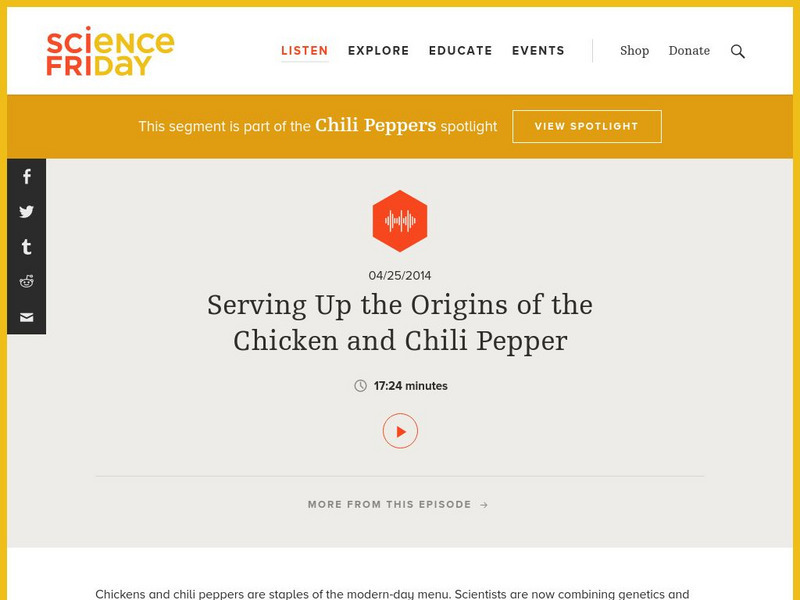Hi, what do you want to do?
TED-Ed
Mysteries of Vernacular: Miniature
Scribes once had to copy books by hand, and it was this process that birthed the word miniature. Watch as minium, or red lead used for pigment in ink, becomes miniature. The resource, part of a series of videos on vernacular, includes...
TED-Ed
Mysteries of Vernacular: Hearse
What do a wolf, a rake, and frame have in common? They are all part of the background of the word hearse. View the video for an explanation, and accompanying animation, of just how the word hearse came to be. Check out the additional...
TED-Ed
Mysteries of Vernacular: Sarcophagus
Tackling etymology in your language arts or linguistics class? Starting a unit on Egypt or ancient Rome? This video details the grim past of the word sarcophagus, tracking it back to the early Roman empire. Included along with the quick...
TED-Ed
Mysteries of Vernacular: Fizzle
Where do words come from? Watch this quick video to find out the origins of fizzle. The narrator mentions some amusing details about fizzle's past, describing a few changes in meaning that have happened over many years. Teach your class...
TED-Ed
Mysteries of Vernacular: Keister
A brief history of kiester, the video leads viewers through the development of the word, starting with kista, Proto-Indo-European for a woven container. The animated video follows kista through its developments and shifts in meaning. Fun...
TED-Ed
Mysteries of Vernacular: X-Ray
What is they mystery behind the name of the x-ray? Find out in a brief informational video that tracks the etymology back to Descartes. Class members can watch the video and then interact with the additional resources. Flip the lesson to...
TED-Ed
Mysteries of Vernacular: Zero
Travel back thousands of years to the origin of the number system and watch how that development gradually produced the zero symbol. Class members will learn a little bit about math and a little bit about how language is shaped in this...
TED-Ed
Mysteries of Vernacular: Gorgeous
What does a wimple have to do with being gorgeous? Watch the video to find out! Learners can observe the development of word meaning over centuries in just two minutes' time. Fun for a warm-up or closing activity, the video is...
TED-Ed
Mysteries of Vernacular: Window
The word window has origins in metaphor and Old Norse. Teach your class about how words develop and about kennings, or metaphoric compounds, with the video and provided additional materials. The video is nicely animated and clearly...
TED-Ed
Mysteries of Vernacular: Inaugurate
The United States inaugurates a president every four years, but where does the word inaugurate really come from? Watch the video to find out and then read a few famous inaugural addresses, which are linked in the Dig Deeper section...
TED-Ed
Mysteries of Vernacular: Tuxedo
Would you have guessed that the word tuxedo comes from a Native American word? Viewers can learn about how words become anglicized and watch the development of tuxedo. An engaging tidbit to show to your class before a unit on the...
TED-Ed
Mysteries of Vernacular: Venom
Choose venom as the word of the day and demonstrate the word's origins with a quick video. The narrator draws parallels between venom and its predecessors, briefly explaining history along the way. Check out the additional materials for...
TED-Ed
Mysteries of Vernacular: Dynamite
Start class off with a bang! Check out this video, part of a series on word development, which tracks the meaning of the word dynamite back to the inventor of dynamite, Alfred Nobel. After perfecting his invention, Nobel created the word...
BBC
Bbc Audio Interviews: Noam Chomsky
Two interviews with noted American linguist and political activist, Noam Chomsky.
Crash Course
Crash Course History of Science #4: India
You might recognize the names of some of the Greek philosophers, but they weren't the only people making knowledge in ancient times. This Crash Course video discusses Indian contributions to philosophy, math, medicine, and astronomy....
Science Friday Initiative
Science Friday: Serving Up the Origins of the Chicken and Chili Pepper
Scientists are combining genetics and linguistics to trace the origins of these staples of the modern-day menu.




















